

ADW: Home. Science revision worksheets: Invertebrates, vertebrates and ecosystems. Huge Rabbit!!! Emperor Penguins keep warm in an ever-shifting huddle. Snow chicks venture onto the ice and into the huddle In these two clips from the BBC's Snow Chick: A Penguin's Tale, emperor penguin chicks venture from their parents' pouches into their communities.
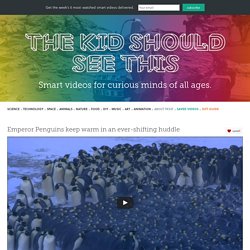
Kate Winslet dramatizes their transitions with her narration. Inspiring images. View our archive of stunning photography, courtesy of 2020VISION, the biggest photography-based conservation project ever undertaken in the UK. www.2020v.org Redstarts are immediately identifiable by their bright orange-red tails, which they often quiver.
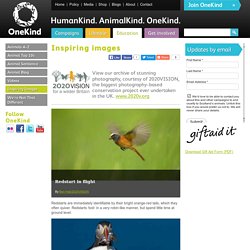
Redstarts ‘bob’ in a very robin-like manner, but spend little time at ground level. Animal Games for Kids - Kids Corner. Fish: Video Archive (Science Trek: Idaho Public Television) Nature School. 1. ANIMALS CLASSIFICATION: VERTEBRATE AND INVERTEBRATE. 2. Classifying Animals (Brain Pop Jr) 2. Animal Classification for Children: Classifying Vertebrates and Invertebrates for Kids - FreeSchool.
Animal Diet Game - Science - Sheppard Software Educational Games for kids. Animal Diet 2 Game - Science - Sheppard Software Educational Games for kids. Animal Characteristics & Classification Game - Science - Sheppard Software Educational Games for kids. 3. Animal Classification Song. Educational Video for Kids. OVIPAROUS AND VIVIPAROUS ANIMALS. Animals classification. Educational Videos For Kids.
Kid's Corner - Warm Blooded and Cold Blooded. All Things Animal TV. Animal Classification. Kid's Corner - animal classification. Animals Types - Based on Living Places - for Kids - Education Videos by www.makemegenius.com. Kinds of Animals. Animal Kingdoms. Vertebrates and Invertebrates Animals (part 1) THE VERTEBRATES SONG. Mammals song. Amazing Facts about Mammals - Science With Kids. Nature_PBS.org. Educational Video for Kids. Educational Video for Kids.
Educational Video for Kids. Facts About Frogs. Lots of Animal Quizzes! - info and online games. Baby Tales ~ Breeding Habits. Zoology. Photos: (A special thanks to the California Academy of Sciences for their generous photo contribution); Introductory page American robin, Asian multicolored ladybird beetle, crocodile skink, Jeffery pine, long-tailed salamander, red lionfish, robust lancetooth, smooth flower coral, Salmonella enteriditis: refer to Organism Pages credits below; Joel Cracraft: courtesy of Joel Cracraft, AMNH Cladogram page DNA: courtesy of Denis Finnin, AMNH, The Genomic Revolution Exhibit animals: AMNH, spectrum of life in Hall of Biodiversity; Bilateria: formosan subterranean termite: courtesy of Scott Bauer, Agricultural Research Service; vertebrates, tetrapods, sauropsids, diapsids: AMNH, Hall of Vertebrate Origins; How to Read a Cladogram page: fruit photos excluding watermelon: AMNH; watermelon: courtesy of Ken Hammond, U.S.
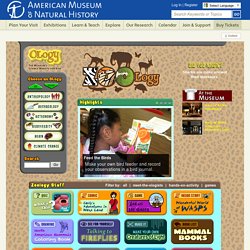
Animal Fact Sheets. The Learning Zone: Animals. Animals Worksheets and Resources. StudyJams. Life Cycle of a Butterfly. Learn Series For Kids. Invertebrates: Animals without Backbones. The invertebrates song. Icky Insects by Silly Bus. Food Chain - Kid's Corner. The Food Chain Every living thing needs energy in order to live.
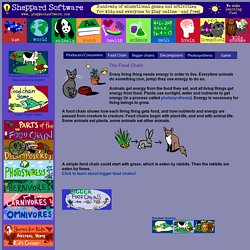
Everytime animals do something (run, jump) they use energy to do so. Animals get energy from the food they eat, and all living things get energy from food. Plants use sunlight, water and nutrients to get energy (in a process called photosynthesis). Energy is necessary for living beings to grow. A food chain shows how each living thing gets food, and how nutrients and energy are passed from creature to creature.
A simple food chain could start with grass, which is eaten by rabbits. Animals. Www.kidcyberteachers.com.au Need help planning classroom activities?
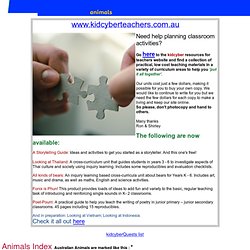
Go here to the kidcyber resources for teachers website and find a collection of practical, low cost teaching materials in a variety of curriculum areas to help you 'put it all together'. Our units cost just a few dollars, making it possible for you to buy your own copy. We would like to continue to write for you but we need the few dollars for each copy to make a living and keep our site online. So please, don't photocopy and hand to others. Many thanks Ron & Shirley The following are now available: A Storytelling Guide: Ideas and activities to get you started as a storyteller. Looking at Thailand: A cross-curriculum unit that guides students in years 3 - 6 to investigate aspects of Thai culture and society using inquiry learning. 4-H Virtual Farm.
Wild - Amazing Animals: Melbourne Museum. Ocean Food Web. Peer into an underwater world.
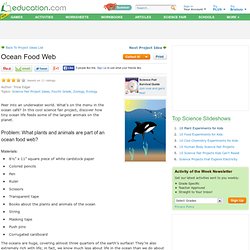
What’s on the menu in the ocean café? In this cool science fair project, discover how tiny ocean life feeds some of the largest animals on the planet. Materials: 8½” x 11” square piece of white cardstock paper Colored pencils Pen Ruler Scissors Transparent tape Books about the plants and animals of the ocean String Masking tape Push pins Corrugated cardboard The oceans are huge, covering almost three quarters of the earth’s surface! Whales are one of the most recognizable marine mammals, and people love to visit the Pacific Northwest to go whale-watching. Seals are common in the Pacific Northwest, and they will often pop up next to you if you’re in a boat. These marine mammals like to munch on fish as well—usually fish like herring or salmon.
Eagles4kids - Home. Animal Lapbooks FREE. Materials and information on this website belong to the original composers.

It may be used for your own personal and school use. Material may not be used for resale. © 2005-07 HSS Materials and information on this website belong to the original composers. It may be used for your own personal and school use.